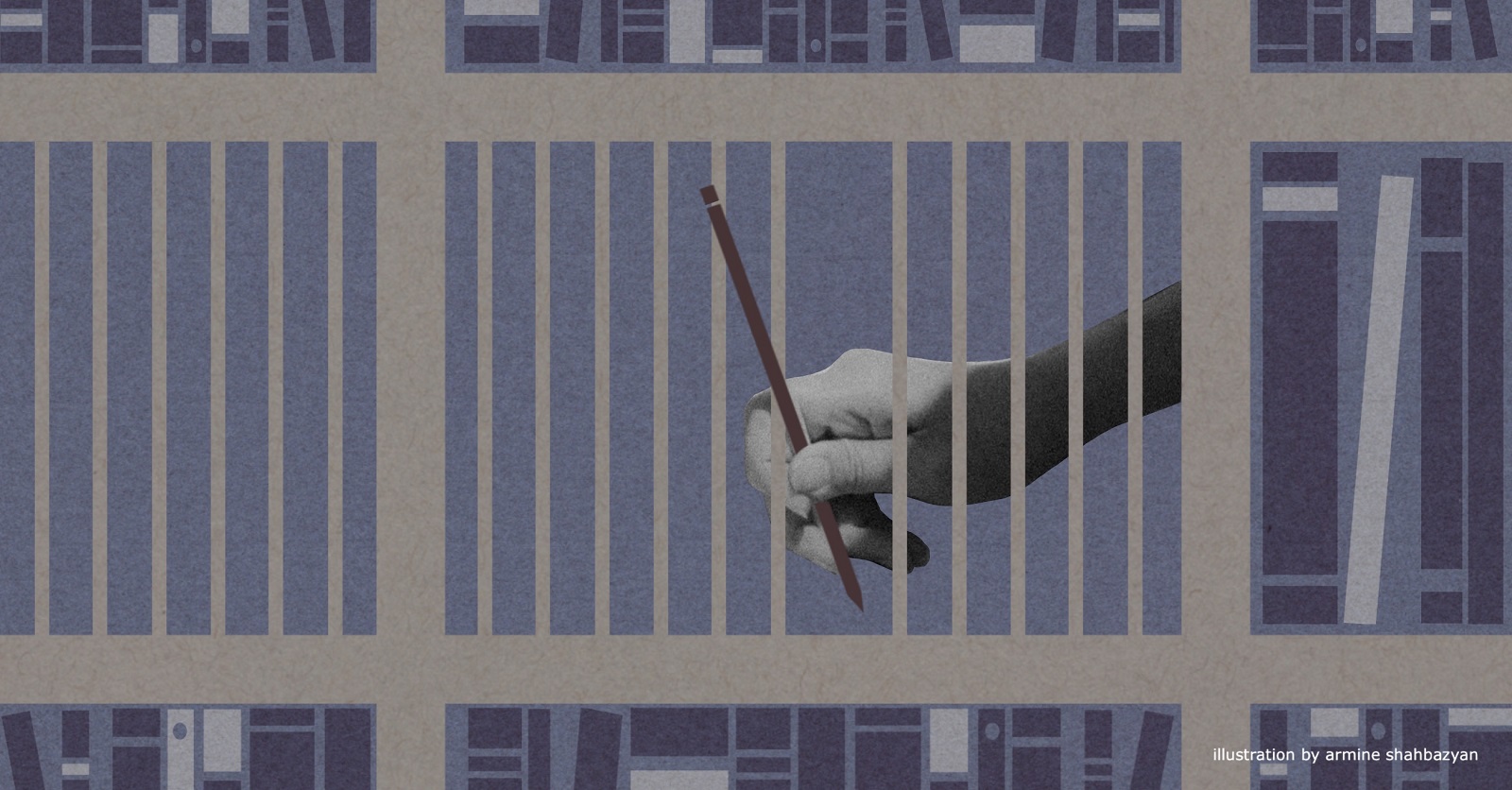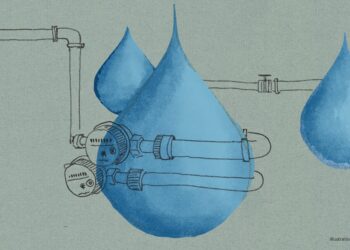
Listen to the article.
The room is filled with the chirping of sparrows. They come and go freely through the barred windows of the building—the only creatures who have freedom here. Unlike the lower levels, the fifth floor of the Nubarashen Penitentiary, where prisoners serving a life sentence are held, is quiet.
“I hadn’t touched a tree in 13 years. When we got COVID, we were taken to the Prisoners’ Hospital, where we finally had the chance to go outside into the yard. I have been in the same room for 13 years without leaving the building. When you stay in the same cell for years, your perception of the world completely changes. I don’t know, maybe it’s necessary, no, maybe it’s not, but the people here will understand what I mean,” says 35-year-old Sargis, who was sentenced to life imprisonment for murder at the age of 20.
“But why haven’t you gone outside? Don’t you have the right to go for a walk?”
“The place for walking here is upstairs. It’s just a regular cell, only open—you can see the sky.”
Sargis
His solution for remaining “sane” while in captivity has always been to stay busy. He learned Italian, improved his English skills, and continued and completed his unfinished education at the National Polytechnic University. Murad Galstyan, the deputy head of the Nubarashen Penitentiary, says that Sargis was an excellent student, and the dean personally came to hand him his diploma. Later, he chose a new profession.
“With nothing to do here, I started learning programming. My cellmate helped me. Now we work together and already have a contract,” Sargis says, adding that his salary from the private company is enough to cover his daily expenses.
“Who cleans your cell?”
“We live here, so naturally we clean it.”
“In movies, there are often conflicts about cleaning, right?”
“It’s just the two of us. Don’t believe those movies too much,” he smiles.
“Was it always just the two of you?”
“No, not always. Our other friends went to Armavir Penitentiary. At first, we wanted to go too, but they wouldn’t take us. Later, when they offered, we decided to stay.”
“Why didn’t you want to go?”
“We had so much work by then, that by the time we got there we wouldn’t have had time for it.”
He explained that they often work after working hours. Although they don’t have a computer in their cell, they use books and a blackboard to read, discuss, and work on projects until they can access a computer. Without internet access, they receive and submit assignments through an electronic storage device––a process that complicates and slows down their work.
Sargis said they had requested permission to use certain websites related to their work: “Well, it’s easier to ban something than to control it––that’s why they ban it. Since we’re the first programmers here, they never even considered something like this when developing the law.”
According to him, authorities believe internet access will lead to new crimes, though he argues there should be an individual approach: “When we can’t complete work quickly due to the conditions, not because we lack ability, our pay suffers. If we had more opportunities to work and earn, we wouldn’t be interested in causing trouble.”
We Don’t Want to Sit Around Doing Nothing
Sargis is one of the few prisoners who not only has a job but also earns a relatively decent income. The majority of prisoners remain unemployed, and among those who do work, paid positions are rare.
According to Armenia’s Penitentiary Service, there were 1,112 incarcerated individuals in 2023. Of these, 117 were assigned to maintenance, facility, or administrative and clerical tasks, 113 engaged in creative work from their cells, 15 worked under contract with external employers, and 137 participated in unpaid labor to improve prison facilities.
In the first half of 2024, 107 inmates were involved in internal support roles, 106 worked in designated work units, 16 were employed by outside companies and 116 did unpaid work improving the premises.
Paid jobs are available within the prison system, but many remain vacant. As of November 22, 2024, 71 of the 139 positions for maintenance, facility, administrative, and clerical duties were unfilled, according to the Penitentiary Service.
Tsovinar Tadevosyan, appointed head of the Penitentiary Service in January 2025 and former head of the Social, Psychological, and Legal Work Division, explained that positions remain vacant due to both the specialized nature of the work (lacking qualified workers) and low interest among prisoners for the available jobs.
She also noted that 15 prisoners had secured contracts with external employers to work remotely as translators, programmers, editors, and in other roles.
The employment of inmates, including those serving life sentences, is regulated by Chapter 21 of the Penitentiary Code. While the Labor Code governs most employer-prisoner relationships, there are some specific provisions for prison employment. Inmates can work for state organizations or other entities operating in the penitentiary, or they may pursue individual labor activities. A government decree specifies prohibited jobs for prisoners, including the production of alcoholic beverages and work that involves using sharp cutting or piercing objects.
Employment priority goes to prisoners who have debts or face financial hardship. The work must be neither compulsory nor exploitative, and cannot serve the personal interests of the penitentiary administration. All workers must receive at least the minimum wage.
According to Murad Galstyan, Deputy Head of the Nubarashen Penitentiary, inmates performing facility maintenance, cleaning, administrative, or clerical work receive equal pay, the minimum wage of 75,000 AMD, (approximately $191 US) to prevent discrimination. Their primary duties involve transporting items and packages.
The salary is deposited into each inmate’s account at the penitentiary.
“Inmates can then use the money as allowed by law to purchase goods or send it to their families,” Galstyan says.
Criminal justice expert Arshak Gasparyan stated that Armenian penitentiaries demonstrate how prisons should not be run: “According to international standards, inmates in a properly functioning facility should have at least eight hours of purposeful activity outside their cells daily. However, today, the majority, except for a few dozen people, remain confined to their cells for up to 23 hours.”
Karen, a 49-year-old inmate serving a life sentence, said that those convicted of serious crimes are denied work within the penitentiary: “I work under contract at a clothing factory as a pattern maker’s assistant. The pay isn’t much. But it’s not about the money, it’s about having something to do. I applied for a job here, but they don’t provide one. It’s not like we want to sit around doing nothing all day.”
Karen was convicted of murder at age 25 and has been incarcerated for the past 24 years. He works on clothing designs from his cell using paper and pencil. His small monthly wage covers only medication—he lists numerous health problems, most of which developed during his imprisonment.
Having a job and income allows prisoners to be more financially independent and less reliant on their families, enabling them to buy their preferred items, food and necessary medication.
“We’re not the only ones ‘doing time’; our families are too,” says Karen, explaining that bringing a package to an inmate often takes an entire day for relatives. They must travel to the prison, typically located far from populated areas, wait in line, and deliver the package. “I have good relatives, a good family. No one has forgotten me, they help however they can. But I don’t want to burden them too much.”
Privileges
Suren, 60, works as the librarian at the Prisoner Hospital while serving an 8.5-year sentence for smuggling. He arrives at work at 11 a.m. daily, coming and going as needed. “Many people read books here,” he explains. “They often request Alexandre Dumas, and some read Armenian books. Whatever they ask for, we have it. We have 2,500 books—I have a list, I give it to them, they look through it, and tell me which book they want.”
Suren does not get paid for this work.
In addition to paid employment, prisoners may volunteer for up to two hours of daily maintenance work within the facility or its surroundings, provided they give written consent.
“These tasks are considered positive behavior for inmates,” explains Armen Davtyan, vice president of the NGO For Freedom and a former convict. “They can earn points toward conditional early release, and ultimately, it gives them something to do outside their cells,”
Working and learning offer multiple benefits; they not only help prisoners acquire skills and stay active, but also increase their chances of early release by demonstrating a commitment to rehabilitation and reintegration.
Article 102 of the Penitentiary Code allows prisoners to be rewarded for conscientious attitude toward work or study. Rewards can include expressions of gratitude, additional phone or video calls, extended visitation rights, temporary prison leave, longer walking hours or changes in their security status.
Furthermore, Article 85 of the Criminal Code enables courts to grant early release to prisoners if they have demonstrated good behavior during their sentence and pose a low risk of reoffending. Participation in available work or educational programs is one of the key factors considered during this assessment.
Opportunities
Work and education are considered vital tools for prisoner rehabilitation. The Penitentiary Code outlines seven main measures, including employment opportunities and access to general, vocational, and higher education.
The State Non-Commercial Organization Center for Legal Education and Rehabilitation Programs implements rehabilitation and educational programs for prisoners, detainees, and individuals under probation.
According to the center’s director, Hayk Sanoyan, they are currently running an art education and training program for offenders. This comprehensive initiative aims to counter the influence of criminal subcultures and establish restorative justice. The program develops skills in education, art, and craftsmanship while promoting rehabilitation through personal development and positive changes in their values.
“This resocialization program operates through non-formal education, allowing participants to study decorative arts, welding, construction skills, leatherworking, furniture-making, and other similar trades,” notes Sanoyan.
According to the Penitentiary Service, 185 people participated in these non-formal educational programs in 2023, with 82 participating in the first half of 2024.
The center also provides formal educational programs for people of all ages. Until August 2022, only those under 19 had access to general education. However, with the amendment to the Law on Education, all convicts gained the right to free general education regardless of age. The Penitentiary Service reported that 53 convicts participated in this program in 2023. In the first half of 2024, participation decreased from 40 people at the start to 31 by the end.
Between 2020 and 2024, around 1,000 convicts completed professional training in languages, business literacy, decorative applied arts, and other fields, according to the center’s data. The Penitentiary Service reports that eight individuals received higher and postgraduate education in 2023, with six more in the first half of 2024.
When asked how many graduates found employment after receiving professional or higher education, both the Center for Legal Education and Rehabilitation Programs and the Penitentiary Service indicated they maintain no such statistics.
Regarding employment opportunities, Hayk Sanoyan explained that while the center does not currently run employment programs, it plans to establish production workshops and offer paid positions to graduates of their non-formal education programs.
Sanoyan suggested that offering tax or other incentives to businesses could encourage them to establish production facilities in penitentiaries and create jobs for convicts.
Marginalized Detainees
Like convicted prisoners, pretrial detainees experience the full impact of losing their liberty, but with even fewer opportunities for employment and education.
According to the Penitentiary Service, no detainees participated in paid work during 2024–2025. When it comes to unpaid work, only 27 detainees took part in 2023, and just 22 in the first half of 2024.
Tsovinar Tadevosyan explains that enrolling detainees in long-term educational programs is generally considered ineffective, except for those under the age of 19, since changes in their legal status may interrupt the continuity of education. Still, penitentiary administrations strive to support those who had already been enrolled in educational programs prior to their detention, helping them continue their studies where possible.
According to the Human Rights Defender’s annual report, as of December 31, 2023, Armenia’s penitentiary institutions housed 2,471 incarcerated individuals. Of these, 1,317 were detainees, accounting for more than 53% of the total prison population.
Our Future Neighbor
Inmates almost universally report experiencing psychological distress and chronic tension, often attributing it to the lack of purposeful activity and the monotony of life behind bars.
“You wake and sleep with bars in front of your eyes,” says Karen. “They’ve installed three layers of grilles over the window, blocking even sunlight. That alone feels degrading. This is the age of technology—if it’s about security, they could use sensors instead.”
The Human Rights Defender’s annual report underscores this problem of inadequate engagement for incarcerated individuals, warning that prolonged inactivity can lead to heightened interpersonal tensions, emotional instability, and frequent behavioral outbursts.
Karen has spent decades behind bars. “You sit in uncertainty. Many of my cellmates have died. The last one passed away just a month ago—we had shared the same cell for 20 years.
“Imagine that. We shared our lives five or six times over. There was nothing new to say. Nothing we hadn’t already discussed. Eventually, we didn’t need words—we understood each other with a glance. How many times can you retell the same stories over two decades? We became like family. That’s not to say we never argued—of course we did, especially about politics. But then we’d stop ourselves and say, ‘What are we even fighting about?’”
Criminal justice expert Arshak Gasparyan emphasizes the long-term societal implications: “The penitentiary system must ensure that people do not leave prison angry, broken, or estranged. We must finally acknowledge that today’s prisoner is tomorrow’s neighbor.”
*The names of the convicts have been changed to protect their identity.
Click here for photos.
Also see
Motherhood Behind Bars
Exploring the lives of incarcerated mothers at Armenia's Abovyan Penitentiary, Astghik Karapetyan delves into the challenges of raising children in confinement, the impact on maternal bonds, and the institutional efforts to balance rehabilitation with the children’s best interests.
Read moreLaw & Society
The Housing Program Helping to Revitalize Armenia’s Border Settlements
Armenia’s state-funded housing program is transforming border settlements, providing thousands of families with new homes while boosting local economies. With strong demand leading to expansion, the initiative is revitalizing rural communities, increasing property values, and encouraging both local and displaced residents to settle and thrive.
Read moreAnatomy of a Process: Yerevan Transportation Reform
Yerevan's ongoing transportation reform, launched in 2017, highlights the lack of strategic planning, leadership and accountability. Without a comprehensive approach, clear oversight and implementation, any reform process will not fulfill its intended goal: to benefit the public.
Read moreReservoirs: Key to Armenia’s Water Security Amid Climate Change
Armenia faces mounting water security challenges as climate change intensifies floods and droughts. Reservoirs can play a pivotal role in managing these risks, ensuring water availability and supporting sustainable development through improved storage, infrastructure, and strategic planning initiatives. Hranoush Dermoyan explains.
Read moreNew Law on Higher Education: Meaningful Reform or Top-Down Policy?
A new Draft Law on Higher Education and Science has ignited public debate in Armenia. While introducing necessary reforms, experts fear certain amendments could threaten the core principles of the higher education system, including academic autonomy, regional equity and free competition.
Read moreAbundance of Both Water and Mismanagement
Armenia faces growing challenges in managing its water resources. Lake Sevan, a crucial water source, is being overused for irrigation, raising concerns about long-term sustainability. Mariam Tashchyan explores the factors behind Armenia’s water crisis.
Read moreArmenia as a Refuge: Who’s Seeking Asylum?
In recent years, there has been an unprecedented increase in the number of asylum seekers in Armenia. Arshaluys Barseghyan looks into what accounts for this trend, which countries Armenia receives the most applications from, and how many are accepted.
Read moreWater and Sanitation Crisis in Armenian Schools
Armenian schools face a severe water and sanitation crisis, worsened by a rising number of refugees. Joya Lahoud examines the impact on health, educational equality, rights, and inclusivity, highlighting the urgent need for comprehensive solutions and improved infrastructure.
Read moreEssential and Ongoing Steps Toward Legal Reform
Astghik Karapetyan addresses the process being implemented to ensure the continuity of judicial reforms, scrutinizing the implications of revamped qualifications for judges and examining challenges surrounding judicial conduct.
Read more










